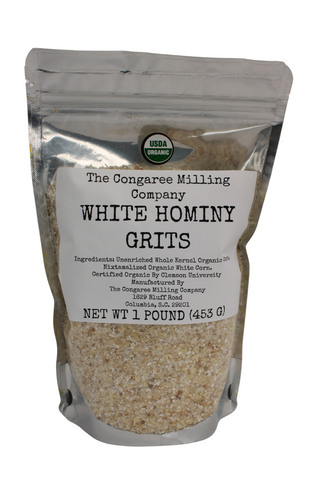Coarse Blue Hominy Grits
$ 6.75
The only real blue hominy grits available on the market! A unique flavor you can get nowhere else. Blue hominy grits contain nixtamalized organic blue corn and organic blue corn. Our blue corn grits are like no other.
Our products are freshly milled and shipped to your door.
Blue corn has a robust and earthy flavor, with a nuttiness and hints of umami. The superior quality of the blue corn we mill combined with the freshness of the grind takes the flavor of this product to new dimensions.
The same anthocyanins that make blueberries blue give blue corn its distinctive color, so it is also good for you. Anthocyanins are variety of flavonoid polyphenol phytonutrients that are strongly believed to have a number of health benefits. Among these benefits are improved brain health, heart health, reduced risk of cancer, reduced inflammation, improved blood sugar control, improved weight management, and improved brain function.
Give it a try in your kitchen for flavor and health!
Our Coarse Blue Hominy Grits are USDA Certified Organic, whole-grain, stone-ground, and vegan. It is a GMO free and gluten free product.
Want to know more about grits? Read on!
Here are some instructions on how to cook grits.
I always cook mine with a bit of salt and then add butter to finish. Grits are also delicious with some cheese.
Grits are ground up corn (Zea Mays). They are ground from dry field corn (not the sweet corn you eat on the cob during summertime). Field corn stays in the field until the kernels are dry enough to store without getting moldy (under 15.5% moisture content). Although field corn goes through the "milk stage" that sweet corn is harvested at, it is not sweet. It is instead starchy. Nixtamalized corn is also field corn.
Gerard Paul at manyeats.com wrote a thorough but concise article about corn that covers the topic quite well. Please give it a read here.
"Stone ground" refers to the mill the corn is ground with. That means the corn was ground on a stone burr mill. Offhand, I can think of four different kinds of mills: stone burr, hammer, roller, and flail. Stone-ground products are ground on a stone burr mill. A stone burr mill is not required to mill grits, but they would not be stone-ground otherwise.
"Stone burr" simply means that the grinding part of the mill is made from stone, i.e., rocks (although some manufacturers use synthetic stones in their mills). "Burr" refers to the carvings on the grinding side of the millstones, A flat stone isn't as good as grinding as a stone that has been shaped with a pattern to assist in grinding grain (referred to as "grist" by millers). This pattern is referred to as "lands" and "furrows." Lands are the high spots, and furrows are the low spots. These shapes interact to cut the grain into uniform sizes.
Millstones may be arranged in a horizontal or vertical fashion. One of the stones called the "runner stone" spins. One stone is stationary, the "bedstone" or "set stone."
Modern stone burr mills are generally powered by electricity, but old-fashioned water-turned mills still count, as do the even more primitive horse-powered mills, or even windmills. For that matter, human turned querns count also. As long as the grinding part of the mill is comprised of stone, the product being milled is stone ground.
To summarize: stone ground grits are corn that has been ground on a stone burr mill.
What is a gristmill? Check out an article I wrote about the topic here.
Check out this list of gristmills compiled by author Amy Halloran (thank you Amy!).
Here is a list of gristmills in South Carolina graciously compiled by SCIWAY.net. A very special thanks to Kerri.
We are proud members of the SCSFA.
We attend several farmer's markets in out local area: The Blythewood Farmer's Market, and the Richland County Public Library's Farmer's Market. Come visit us at the Farmer's Market.
We are also pleased to announce that Fundacion Tortilla was kind enough to include us in their directory of all things related to corn and nixtamal. Their primary focus is to preserve the diversity of indigenous corn culture. We are proud to be their allies.




Share this item: